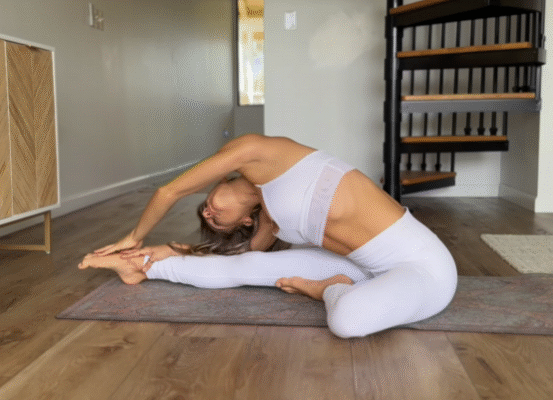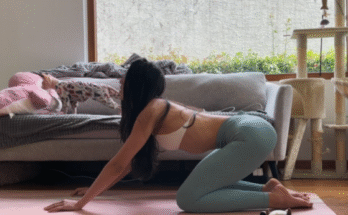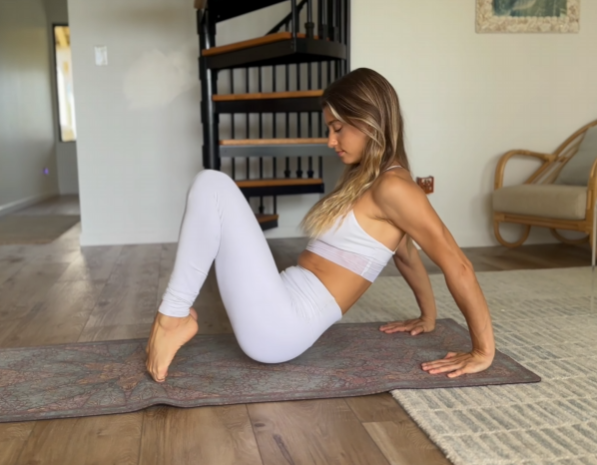
Yoga is not only a practice of strength or flexibility—it is a practice of awakening. A body-opening yoga practice is about creating space in the joints, muscles, and connective tissues, and simultaneously releasing tension stored from daily life. This session focuses on gentle yet deep stretches, mindful movements, and breath awareness to help you feel lighter, freer, and more connected to your own body.
Whether you are coming off a long day of sitting, completing an intense workout, or simply looking to wake up your body in the morning, this full-body routine will help you release tightness, improve circulation, and cultivate inner awareness. Here’s a detailed 1000-word guide to a body-opening yoga practice.
1. Arrival and Breath Awareness (1 Minute)
Begin seated in a comfortable position—cross-legged, on a block, or kneeling. Close your eyes and draw your attention inward.
Take slow, deep breaths:
- Inhale through your nose, feeling your ribs expand and your chest lift.
- Exhale through your nose, releasing tension from your shoulders and back.
Place your hands on your knees or thighs. As you breathe, visualize opening space in the body with each inhale and softening with each exhale. This is your moment to transition from the outside world to your inner body.
2. Neck and Shoulder Release (1 Minute)
Begin with gentle neck movements:
- Drop your right ear toward your right shoulder.
- Slowly roll your chin down toward your chest, then over to your left shoulder.
- Repeat 2–3 times, keeping the shoulders relaxed.
Next, roll your shoulders backward in large, slow circles, then forward.
- This movement releases tension in the neck, traps, and shoulders—areas that often store stress and stiffness.
Finish with interlacing your fingers behind your back, lifting the chest slightly, and drawing the shoulder blades together. Hold for a few breaths.
3. Cat-Cow Flow (1 Minute)
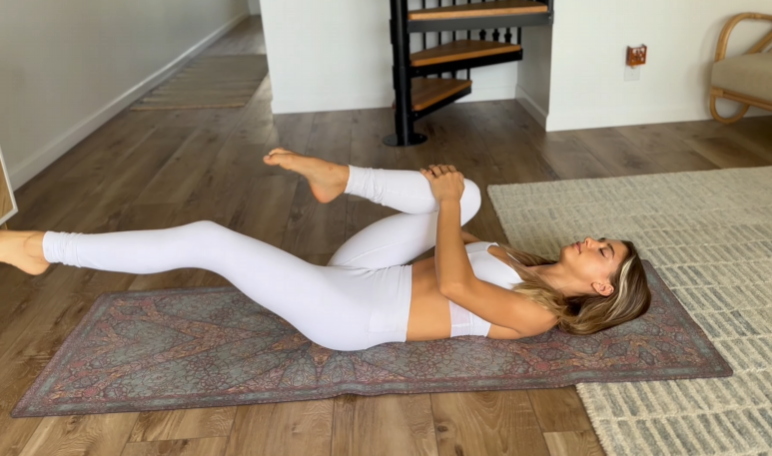
Come to all fours, wrists under shoulders, knees under hips.
- Inhale (Cow Pose): Drop your belly, lift your chest, gaze slightly upward.
- Exhale (Cat Pose): Round your spine, tuck your chin, and press into your hands.
Repeat 8–10 times. Focus on the fluid motion between rounding and arching, releasing tension in the spine while creating flexibility in the thoracic and lumbar areas. Cat-Cow awakens the body and prepares it for deeper opening.
4. Thread the Needle (1 Minute)
From all fours:
- Slide your right arm underneath your left arm, resting your shoulder and ear on the mat.
- Keep your hips high or slightly sink them for a deeper twist.
- Hold 30 seconds, then switch sides.
This twist releases the upper back, shoulders, and chest, helping to improve posture and relieve tension accumulated from sitting or working at a desk.
5. Low Lunge with Side Stretch (1 Minute)
Step your right foot forward between your hands into a low lunge, left knee on the mat.
- Place your right hand on your thigh, extend your left arm overhead, and gently side bend to the right.
- Hold for 5–6 deep breaths.
- Switch sides.
This posture opens the hip flexors, quads, and side body while lengthening the spine and enhancing mobility. Tight hips often restrict your movement and affect your lower back, making this pose essential for body opening.
6. Downward Facing Dog (1 Minute)
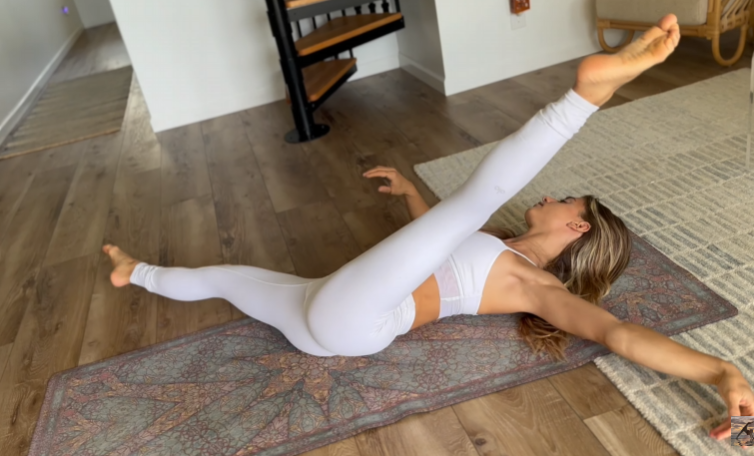
From tabletop, tuck your toes under, lift your hips, and extend your arms forward.
- Press evenly into your hands and feet.
- Draw your heels toward the floor for a gentle hamstring stretch.
- Relax your head and neck between your arms.
Downward Dog stretches the shoulders, hamstrings, calves, and spine. It also encourages circulation and energizes the whole body. Pedal your feet to deepen the stretch, alternating legs.
7. Standing Forward Fold with Shoulder Stretch (1 Minute)
Come to a standing position, feet hip-width apart.
- Interlace your fingers behind your back.
- Hinge at your hips and fold forward, letting your chest and hands drop toward the floor.
- Hold 5–6 breaths.
This pose releases the hamstrings, calves, shoulders, and chest. The gentle inversion of the head also calms the nervous system.
8. Wide-Leg Forward Fold (Prasarita Padottanasana) (1 Minute)
Step your feet wide apart, toes slightly turned in.
- Hinge at your hips and fold forward, hands on the floor or holding your ankles.
- Let your head and neck relax completely.
- Optionally, clasp your hands behind your back and stretch them overhead.
This stretch targets the hamstrings, inner thighs, calves, and spine, while creating space in the shoulders and chest. It’s excellent for opening tight leg muscles while lengthening the torso.
9. Seated Spinal Twist (1 Minute)
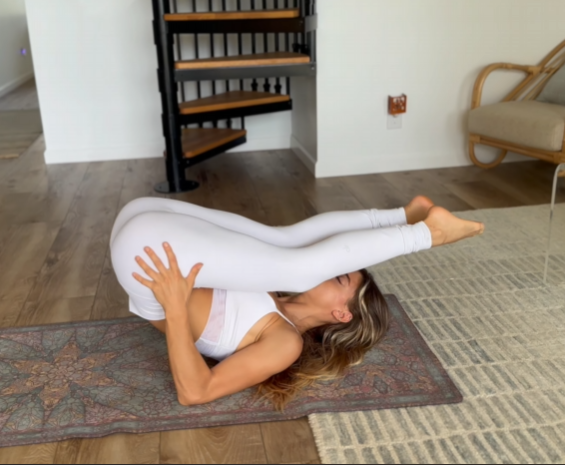
Sit with legs extended. Bend your right knee and place your foot outside your left thigh.
- Place your right hand behind you for support.
- Inhale, lengthen your spine; exhale, twist gently toward your bent knee.
- Hold for 4–5 breaths, then switch sides.
Twists open the spine, massage the internal organs, and relieve tension in the back muscles. This pose enhances flexibility and promotes detoxification.
10. Reclined Figure Four (1 Minute)
Lie on your back.
- Cross your right ankle over your left thigh, forming a “figure four.”
- Thread your hands behind your left thigh and gently pull toward your chest.
- Hold 30 seconds, then switch sides.
This posture stretches the hips, glutes, and outer thighs. It is particularly useful for releasing tightness in the gluteal muscles and hip joints, which often store tension and stress.
11. Supine Chest Opener (1 Minute)
Lie on your back. Place a pillow or rolled blanket under your shoulder blades for support.
- Let your arms fall open to the sides, palms facing up.
- Allow your chest to lift gently toward the sky.
Close your eyes and take deep breaths. This heart-opening posture relaxes the chest and shoulders, reduces stress, and encourages emotional openness.
12. Happy Baby (Ananda Balasana) (1 Minute)
From lying on your back, bend your knees toward your chest.
- Grab the outer edges of your feet or ankles.
- Gently pull your knees toward your armpits.
- Rock slightly side to side if it feels good.
Happy Baby releases tension in the hips, lower back, and inner thighs while promoting playful movement. It’s a joyful way to end a full-body opening sequence.
13. Final Relaxation (Savasana) (1 Minute)
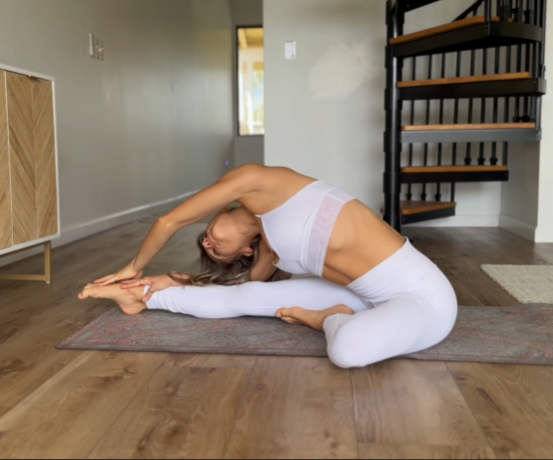
Lie flat on your back, legs extended, arms resting at your sides, palms up.
- Close your eyes and breathe naturally.
- Let every part of your body sink into the mat.
- Imagine tension melting away with each exhale.
Spend this final minute absorbing the benefits of your practice. Your body is more open, your muscles relaxed, and your mind calm.
Why a Body-Opening Practice Matters
This practice not only increases flexibility but also:
- Improves posture
- Releases muscle tension
- Enhances circulation
- Reduces stress and mental fatigue
- Increases joint mobility
- Promotes emotional balance
Daily body-opening routines restore the natural length and function of your muscles, helping you move more freely in everyday life. Even 10–15 minutes a day can make a remarkable difference.
Tips for Maximum Benefit
- Move slowly and mindfully—never force a stretch.
- Sync every movement with your breath.
- Focus on sensation rather than appearance.
- Use props like blocks, blankets, or straps if needed.
- Stay consistent—even a short daily routine improves flexibility over time.
- Listen to your body—honor where tension resides and release gently.
Closing Thoughts
A body-opening yoga practice is about creating space—physically, mentally, and energetically. Each inhale invites expansion; each exhale invites release. By dedicating time to open the hips, spine, chest, and shoulders, you unlock mobility, alleviate tension, and cultivate a sense of calm and freedom.
Remember, yoga is not about how far you can bend or how flexible you are—it’s about awareness, presence, and the relationship you cultivate with your own body. Allow this flow to be a daily gift to yourself, a few minutes of mindful movement that leaves your body and mind lighter, more open, and deeply restored.
